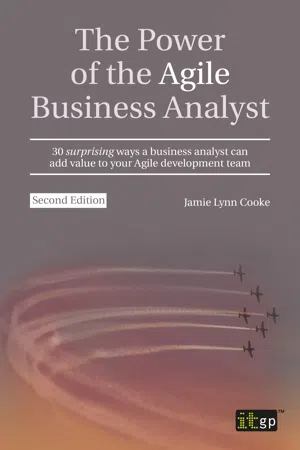
The Power of the Agile Business Analyst, second edition
30 surprising ways a business analyst can add value to your Agile development team
- 195 pages
- English
- ePUB (mobile friendly)
- Available on iOS & Android
The Power of the Agile Business Analyst, second edition
30 surprising ways a business analyst can add value to your Agile development team
About This Book
Now in its second edition, The Power of the Agile Business Analyst has expanded to include new Agile methods that have emerged or gained prominence since the first edition.
- Buy this book to learn how to revolutionise your Agile development and increase the value and relevancy of your project outcomes.
- Learn 30 realistic, achievable ways that an Agile business analyst can increase project efficiency, add value and improve quality.
- Find out how an Agile business analyst bridges the gap between the needs of the business and the resources of the development team.
- Now updated with current Agile methods, to support emerging and established business analysts to adapt to new trends.
Support your Agile business users for better project outcomes
In The Power of the Agile Business Analyst, Jamie Lynn Cooke challenges this approach and questions whether Agile projects that are run in this way can deliver the highest-value business solutions.
Agile developers can access a wide range of resources to help achieve their project goals. In contrast, the Agile business user often has very little support despite holding key responsibilities, such as gathering requirements, managing priorities and providing business knowledge to ensure the best possible solution. The business user also usually has wider responsibilities that make it difficult to give a project their full attention.
30 ways an Agile business analyst can help
Drawing on her extensive experience, Jamie proposes a new role for Agile projects: The Agile business analyst. She details 30 achievable ways that such a role will increase relevance, quality and overall business value, and provide business users with crucial support. The Agile business analyst is also a boon to the development team, being a ready source of business knowledge and ensuring that project outcomes align with requirements.
This book has been updated to:
- Incorporate behaviour-driven development into the work that the business analyst does to support interface design;
- Align the programme management strategies of the Scaled Agile Framework (SAFe) to encourage cross-organisational communication and participation;
- Include full updates throughout the Qualifications section in 'Getting the Right Agile Business Analyst for Your Team'; and
- Provide Agile updates, bringing the book back into line with current methods.
Jamie Lynn Cooke has 27 years of experience as a senior business analyst and solutions consultant, working with more than 130 public and private sector organisations throughout Australia, Canada, and the United States.
Frequently asked questions
Information
CHAPTER 1: WHAT IS AGILE?2
CHAPTER 2: THE POWER AND PERILS OF AGILE
The lopsided process diagram

Table of contents
- Cover
- Title
- Copyright
- Foreword
- Preface
- Author
- Acknowledgements
- Contents
- Introduction
- Chapter 1: What is Agile?
- Chapter 2: The power and perils of Agile
- Chapter 3: Why your team needs an Agile business analyst
- Chapter 4: What are the risks of not having an Agile business analyst?
- Chapter 5: 30 ways for the Agile business analyst to add value to your project
- Chapter 6: Getting the right Agile business analyst for your team
- Chapter 7: Moving your Agile team forward
- Chapter 8: More information on Agile
- Author’s note on Agile business analysis resources
- Further Reading